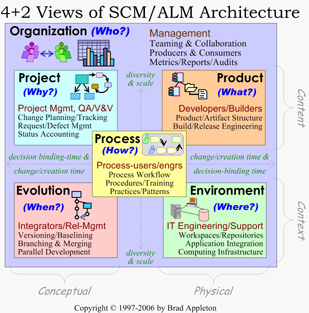- Pitfall #1: No scope change-management
- The very first pitfall they fall into is not having any kind of change-management for the project/requirements. They allow any and all changes in a very reactive fashion without thinking about trying to renegotiate the scope, schedule, or resources for the project/release.
- Pitfall #2: Preventing scope changes
- The very next time around, they run into the second pitfall: they overcompensate for being burned/bitten by the first pitfall by trying to prevent any and all changes to the scope of their next product release.
The irony is that the more they try to get stable detailed requirements up-front, the more the schedule becomes protracted: first to get all the gory-details analyzed and specified up-front; and second because so many of the gory-details were either incorrect or still not detailed enough. It becomes this vicious cycle of trying to prevent change with more up-front detail, and yet things keep getting worse instead of better.
The first thing I commonly do here is explain the following:
- There is a very fancy technical term that biologists use to describe completely stable systems. This highly sophisticated technical term is the word "DEAD!"
Then I tend to mention Phil Armour's description of the Five Orders of Ignorance and how Software is not a Product, and that software development is a therefore a knowledge creation activity which involves reducing our ignorance over time though learning and discovery about the domain (our requirements) and ourselves (our process, culture, and skill/capabilities).
At this point I then introduce them to my "tried and true, battle-proven and industry-acknowledged, Unchangeable Rules of Software Change":
- Rule #0: Change is Inevitable!
- The Requirements/Plans ARE going to change!
- Rule #1: Resistance is Futile!
- There isn’t a darn thing you can do to prevent Rule #0.
- Rule #2: Change is like Quicksand -- Fighting it only makes it worse!
- The more you try to deny and defy rule #1 by attempting to prevent rule #0, the worse things will get.
- Rule #3: Change is like Quicksilver -- Tightening your grip makes it slip from your grasp!
- The more you try to deny and defy rule #2 by attempting to precisely predict, or rigidly control change, the more erratic and onerous the result will be.
- Rule #4: Embrace change to control change
- The more flexible and adaptive you are at accommodating change, the more control you will have over it.
Despite having plenty of historical evidence/data in this particular product to support the "inescapable truth" laid out by these rules, there still seemed to be that desire to cling to the illusion of control that we can somehow prevent such changes if only we spend more time+effort getting a more complete+perfect+detailed spec up-front.
I was searching for external validation ("not invented here") and then came across the following three things that I liked a lot:
- Phil Armour's Jan 2006 CACM article Counting Boulders and Measuring Mountains: Accuracy and the Measurement of Peaks and Projects (Phil's book The Laws of Software Process is one of my favorites)
- Chapter 2 of Karl Wieger's newest book More About Software Requirements (Microsoft Press, 2006; ISBN 0-7356-2267-1) entitled Cosmic Truths About Software Requirements"
- A recent gem of a posting from Per Kroll, Director at Rational Software and co-author of "The Rational Unified Process Made Easy", posted on the IBM/Rational "RUP" discussion forum on Jan 6, 2006:
The fundamentally difficult hurdle managers needs to come across is that when you do not know enough to produce an accurate estimate, it will not help to do a more fine-granular plan. Rather, you need to do a list of what are the unknowns and risks preventing you from doing a more detailed estimate, and then rapidly do the analysis, design, implementation, testing, or other risk mitigation turning unknowns into knowns. This sounds as something that should not be very difficult to understand, but it really is a big mountain to climb for many people...
So, where can your manager get a better understanding on these topics? Some suggestions:- Joe Morasco, Iterative Development,
- Philippe Kruchten, From Waterfall to Iterative Development: A tough transition for project managers, The Rational Edge, December 2000.
- We have a 2-day training course, Mastering Management of Iterative Development (MMID)
- Craig Larman, Agile & Iterative Development: A Manager's Guide, Addison-Wesley, 2004. Excellent book providing tons of research on benefits of iterative development [see the excerpt Software Development: Iterative and Evolutionary]
- Walker Royce: Software Project Management: A Unified Framework, Addison-Wesley-Longman (1998) ISBN 0-201-30958-0
- Murray Cantor: Software Leadership: A Guide to Successful Software Development. Addison-Wesley Professional (2001) 208p. ISBN 0-201-70044-1
- Joe Morasco, Iterative Development,


